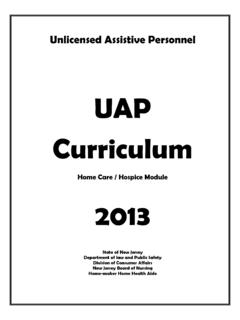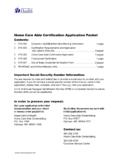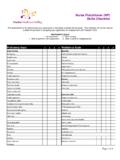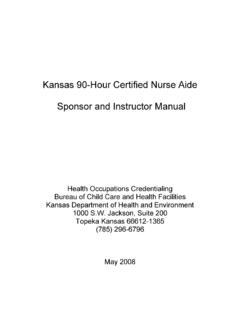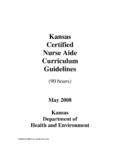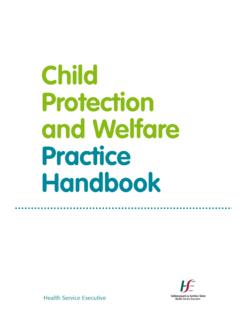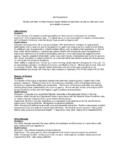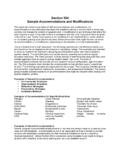Transcription of State of Michigan Department Of Licensing And …
1 State of Michigan Department Of Licensing And Regulatory Affairs Bureau of Community and Health Systems Long Term care Division Paid Dining Assistant Curriculum August 1, 2015 DIRECTIONS FOR USE OF THE DINING ASSISTANT Unit 1 Role of the Dining Role of the Dining Federal Course Resident Unit 2 Communications and Interpersonal Communications Interpersonal Communicating with Residents and Communicating with Residents with Special Observation and Recognizing Behavior Unit 3 Resident Ethics, Confidentiality and Legal Mistreatment of Signs and Examples of Identification of Residents at Risk for Abusing Other Identification of Residents at Risk for Being Report Unit 4 Safety and Emergency Basic Emergency Procedures and Resident Safety Measures to Prevent Accidents and Assisting Residents with The Heimlich Assisting with Heart Assisting Residents with Reporting Emergency Unit 5 Infection Infection Medical Standard Unit 6 Nutrition and General Food Guide Pyramid and Basic Food Therapeutic Adaptive Preparing and Serving Resident s Dining Serving Supplementary Providing Fresh Drinking Challenging Dining Setting up a Meal Tray and Dining a Appendix A Instructional Objectives and Performance Checklist Appendix B Performance Checklist Appendix C Instructional Objectives and Task Checklist Performance
2 I Preface Paid Dining Assistant Curriculum On September 26, 2003, the Centers for Medicare and Medicaid Services (CMS) published the final regulations for requirements for paid dining assistants in Long Term care Facilities (Federal Register/Vol. 68, No. 187/Friday, September 26, 2003/Rules and Regulations, page 5539). The regulations are found under 42 CFR 483, Subpart B , , Subpart D ; and 42 CFR 488 Subpart E House Bill 5389 was signed into law by Governor Snyder on January 10, 2015 and amends the Michigan Public Health Code to allow the use of dining assistance in nursing homes. The federal and State regulations stipulate that facilities must not use any individual employed in the facility as a dining assistant unless that individual has successfully completed a State -approved training program for dining assistants, as specified in the regulations. Under F373 in the SOM, Facilities may use their existing staff to assist eligible residents to eat and drink.
3 These employees must have successfully completed a State -approved training course for paid feeding The regulations do not apply to licensed nursing personnel, or nurse aides. They do not apply to volunteers, families or friends. However, any individual employed by the facility who feeds residents, if only for a short time each day or occasionally, must successfully complete State -approved dining assistant training because s/he is functioning as a dining assistant. This includes individuals whose services at the facility may be paid under contract with another employing agency. For each person providing paid dining assistance, the facility must maintain a record of the successfully completed State -approved curriculum for dining assistants. A facility must ensure that a dining assistant feeds only residents who have no complicated dining problems. Complicated dining problems include, but are not limited to, difficulty swallowing, recurrent lung aspirations, and tube or parenteral/IV feedings.
4 The facility must base resident selection for being fed by a dining assistant on the charge nurse s assessment, the resident s latest assessment, and the resident s plan of care . A dining assistant must work under the supervision of a registered nurse (RN) or licensed practical nurse (LPN). ii In an emergency, the dining assistant must call a supervisory nurse for help using the resident call system. In the SOM under F373 Paid Feeding Assistants, it is noted under the Interpretive Guidelines section: Residents may be receiving assistance in eating or drinking in various locations throughout the facility, such as dining areas, activity room, or areas such as patios or porches in which a resident call system is not readily of where a resident is being assisted to eat or drink, in the case of an emergency, the facility needs to have a means for a paid feeding assistant to obtain timely help of a supervisory nurse.
5 Therefore, for the purposes of this requirement, a resident call system includes not only the standard hard-wired or wireless call system, but other means in an emergency situation by which a paid feeding assistant can achieve timely notification of a supervisory nurse. To meet minimum federal requirements, a program must consist of at least 8 hours of a State approved training course for dining assistants. The course must meet the requirements of and must include the following: (a) Dining techniques. (b) Assisting with dining and hydration. (c) Communication and interpersonal skills. (d) Appropriate responses to resident behavior. (e) Safety and emergency procedures, including the Heimlich Maneuver. (f) Infection control. (g) Resident rights. (h) Recognizing changes in residents that are inconsistent with their normal behavior and the importance of reporting those changes to supervisory nurse. (I) End of life.
6 This curriculum does not include bloodborne pathogen training. Facilities are already required by OSHA to provide this training prior to exposure to individuals with bloodborne pathogens and on an annual basis, thereafter. The principles and application of gloving, gowning, mask and eyewear protection are not included in this curriculum. It is the responsibility of the facility to provide the appropriate training in applying and removing PPE for any individual who needs this type of protection when providing dining assistance to a resident. Material on Standard Precautions is limited to basic required application for all residents and does not address Droplet Precautions, Contact Precautions, or Transmission-Based Precautions. iii This curriculum is approved for meeting the requirements of the regulations governing the training of dining assistants. Additional components that expand the curriculum may be added, but not substituted.
7 A minimum of 8 clock-hours of instruction, including skills competency, is required. All skills in this curriculum should be successfully demonstrated with instructor supervision prior to feeding a resident and prior to completion of the program. No attempts have been made to establish a test or grading system for successful completion. The primary instructor, based on instructor evaluation and documented skills competency, will determine successful completion of the program. The goal of the program is competency, not failure. The course must be taught by qualified licensed health professionals such as a Registered Nurse (RN) or Occupational Therapist. Other licensed health care personnel with at least one year of experience in their fields may supplement the instructor. Up-to-date textbooks are an important learning resource for students. It is recommended that instructors review several and select one that will provide resources to complement the curriculum.
8 To meet minimum State requirements as outlined in MCL to amended to add Section 21794, the following conditions must be met by the facility: a. Receive documented consent from the resident or resident s guardian. b. Maintain a written record for each paid dining assistant which includes: 1. Criminal background check results 2. Complete name and address of the individual 3. Documentation of completion of the PDA training and date of successful completion of program c. A supervising nurse shall be immediately available. d. A dining assistant must not be included in computing the ratio of patients to nursing personnel or used to supplement or replace nursing personnel. e. A dining assistant assigned to provide dining assistance to a resident in their room must not be assigned to another resident at the same time. The paid dining assistant must: a. Be at least 17 years of age or older. b. Not provide any nursing functions, including, but not limited to, assistance with transportation, ambulation, transferring or, toileting residents, or the distribution of medication.
9 Iv c. Pass a criminal background check. Statutory Definitions 1. Dining Assistant: An individual who meets the requirements of this section, is paid by the facility, provides dining assistance to residents, and is not a Registered Nurse, Licensed Professional, or Certified Nurse Aide. 2. Immediately available: Being capable of responding to help if needed at any time either in person, by voice or call light system, radio, telephone, pager or other method of communication during a dining experience. 3. Nurse: An individual licensed as a Registered Professional Nurse or Licensed Practical Nurse under Article 15 to engage in the practice of nursing. 4. Under the Supervision of a Nurse: A nurse who is overseeing the work of a dining assistant is physically present in the nursing home and immediately available. Adequate supervision by a supervising nurse does not necessarily mean constant visual contact or being physically present during the meal/snack time.
10 5. Charge Nurse: The facility must base resident selection for feeding assistance on the charge nurse s (RN or LPN) current assessment of the resident s condition, latest comprehensive assessment, and plan of care . Charge nurses may wish to consult with interdisciplinary team members, such as speech-language pathologists or other professionals, when making their decisions. 6. Supervisory Nurse: May be a RN or LPN. The supervisory nurse should monitor the provision of the assistance provided by paid feeding assistants to evaluate on an ongoing basis: their use of appropriate feeding techniques; whether they are assisting assigned residents according to their identified eating and drinking needs; whether they are providing assistance in recognition of the rights and dignity of the resident; and whether they are adhering to safety and infection control practices. 7. The charge nurse and the supervisory nurse may or may not be the same individuals.










